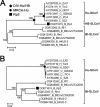Evidence of the recombinant origin of a bat severe acute respiratory syndrome (SARS)-like coronavirus and its implications on the direct ancestor of SARS coronavirus
- PMID: 18057240
- PMCID: PMC2258724
- DOI: 10.1128/JVI.01926-07
Evidence of the recombinant origin of a bat severe acute respiratory syndrome (SARS)-like coronavirus and its implications on the direct ancestor of SARS coronavirus
Abstract
Bats have been identified as the natural reservoir of severe acute respiratory syndrome (SARS)-like and SARS coronaviruses (SLCoV and SCoV). However, previous studies suggested that none of the currently sampled bat SLCoVs is the descendant of the direct ancestor of SCoV, based on their relatively distant phylogenetic relationship. In this study, evidence of the recombinant origin of the genome of a bat SLCoV is demonstrated. We identified a potential recombination breakpoint immediately after the consensus intergenic sequence between open reading frame 1 and the S coding region, suggesting the replication intermediates may participate in the recombination event, as previously speculated for other CoVs. Phylogenetic analysis of its parental regions suggests the presence of an uncharacterized SLCoV lineage that is phylogenetically closer to SCoVs than any of the currently sampled bat SLCoVs. Using various Bayesian molecular-clock models, interspecies transfer of this SLCoV lineage from bats to the amplifying host (e.g., civets) was estimated to have happened a median of 4.08 years before the SARS outbreak. Based on this relatively short window period, we speculate that this uncharacterized SLCoV lineage may contain the direct ancestor of SCoV. This study sheds light on the possible host bat species of the direct ancestor of SCoV, providing valuable information on the scope and focus of surveillance for the origin of SCoV.
Figures





References
-
- Baric, R. S., K. Fu, W. Chen, and B. Yount. 1995. High recombination and mutation rates in mouse hepatitis virus suggest that coronaviruses may be potentially important emerging viruses. Adv. Exp. Med. Biol. 380571-576. - PubMed
-
- Chinese SARS Molecular Epidemiology Consortium. 2004. Molecular evolution of the SARS coronavirus during the course of the SARS epidemic in China. Science 3031666-1669. - PubMed
Publication types
MeSH terms
LinkOut - more resources
Full Text Sources
Miscellaneous

